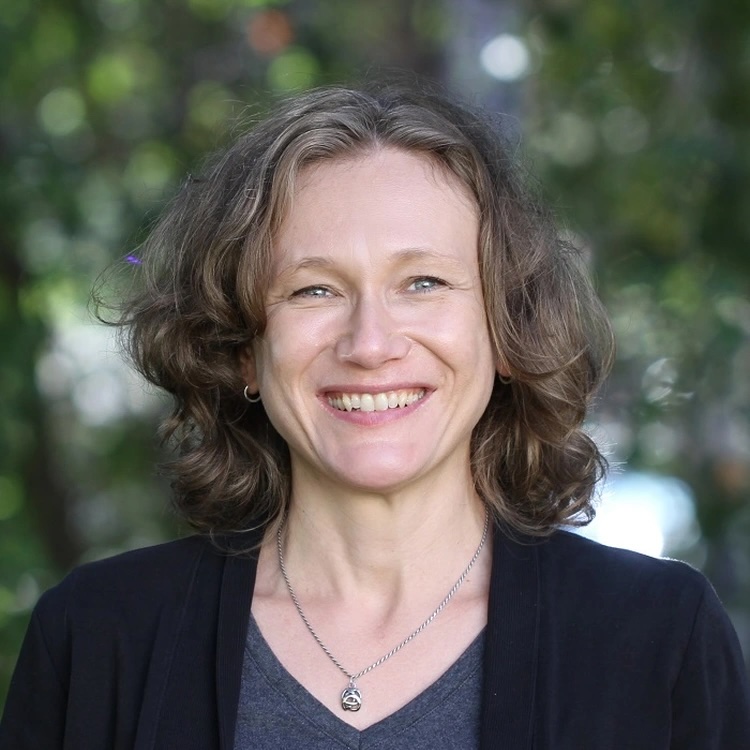Science Team | Anna Michalak
Anna Michalak
Deputy Principal Investigator
Carnegie Institution for Science / Stanford
Anna Michalak is the Director of the Climate and Resilience Hub at the Carnegie Institution for Science and Professor (by courtesy) of Earth System Science at Stanford. She works on characterizing the global carbon cycle and on climate impacts on coastal and inland water quality.
Education
- PhD in Civil and Environmental Engineering | Stanford University | 2003
- MS in Civil and Environmental Engineering | Stanford University | 1998
- BSc(Eng) in Environmental Engineering | University of Guelph, Canada | 1997
Professional Experience
- 2011-present: Faculty member and Director, Carnegie Institution for Science
- 2011-present: Professor (2016 - ) and Associate Professor (2011-2016), Stanford
- 2004-2011: Associate Professor (2010-2011) and Assistant Professor (2004-2010), University of Michigan
- 2003- 2004: NOAA Climate & Global Change (C&GC) Fellow, NOAA\

References
Cui, E., Huang, K., Arain, M. A., Fisher, J. B., Huntzinger, D. N., Ito, A., et al. (2019). Vegetation functional properties determine uncertainty of simulated ecosystem productivity: A traceability analysis in the east asian monsoon region. GLOBAL BIOGEOCHEMICAL CYCLES, 33(6), 668–689. https://doi.org/10.1029/2018GB005909
El Masri, B., Schwalm, C., Huntzinger, D. N., Mao, J., Shi, X., Peng, C., et al. (2019). Carbon and water use efficiencies: A comparative analysis of ten terrestrial ecosystem models under changing climate. SCIENTIFIC REPORTS, 9. https://doi.org/10.1038/s41598-019-50808-7
Famiglietti, C. A., Michalak, A. M., & Konings, A. G. (2021). Extreme wet events as important as extreme dry events in controlling spatial patterns of vegetation greenness anomalies. ENVIRONMENTAL RESEARCH LETTERS, 16(7). https://doi.org/10.1088/1748-9326/abfc78
Hu, L., Andrews, A. E., Thoning, K. W., Sweeney, C., Miller, J. B., Michalak, A. M., et al. (2019). Enhanced north american carbon uptake associated with el nino. SCIENCE ADVANCES, 5(6). https://doi.org/10.1126/sciadv.aaw0076
Huang, K., Xia, J., Wang, Y., Ahlstrom, A., Chen, J., Cook, R. B., et al. (2018). Enhanced peak growth of global vegetation and its key mechanisms. NATURE ECOLOGY & EVOLUTION, 2(12), 1897–1905. https://doi.org/10.1038/s41559-018-0714-0
Huntzinger, D. N., Schaefer, K., Schwalm, C., Fisher, J. B., Hayes, D., Stofferahn, E., et al. (2020). Evaluation of simulated soil carbon dynamics in arctic-boreal ecosystems. ENVIRONMENTAL RESEARCH LETTERS, 15(2). https://doi.org/10.1088/1748-9326/ab6784
Jeong, S.-J., Bloom, A. A., Schimel, D., Sweeney, C., Parazoo, N. C., Medvigy, D., et al. (2018). Accelerating rates of arctic carbon cycling revealed by long-term atmospheric CO<sub>2</sub> measurements. SCIENCE ADVANCES, 4(7). https://doi.org/10.1126/sciadv.aao1167
Kolus, H. R., Huntzinger, D. N., Schwalm, C. R., Fisher, J. B., McKay, N., Fang, Y., et al. (2019). Land carbon models underestimate the severity and duration of drought’s impact on plant productivity. SCIENTIFIC REPORTS, 9. https://doi.org/10.1038/s41598-019-39373-1
Liu, Y., Piao, S., Gasser, T., Ciais, P., Yang, H., Wang, H., et al. (2019). Field-experiment constraints on the enhancement of the terrestrial carbon sink by CO<sub>2 </sub>fertilization. NATURE GEOSCIENCE, 12(10), 809+. https://doi.org/10.1038/s41561-019-0436-1
Miller, S. M., & Michalak, A. M. (2020). The impact of improved satellite retrievals on estimates of biospheric carbon balance. ATMOSPHERIC CHEMISTRY AND PHYSICS, 20(1), 323–331. https://doi.org/10.5194/acp-20-323-2020
Miller, S. M., Michalak, A. M., Yadav, V., & Tadic, J. M. (2018). Characterizing biospheric carbon balance using CO<sub>2</sub> observations from the OCO-2 satellite. ATMOSPHERIC CHEMISTRY AND PHYSICS, 18(9), 6785–6799. https://doi.org/10.5194/acp-18-6785-2018
Miller, S. M., Michalak, A. M., Detmers, R. G., Hasekamp, O. P., Bruhwiler, L. M. P., & Schwietzke, S. (2019). China’s coal mine methane regulations have not curbed growing emissions. NATURE COMMUNICATIONS, 10. https://doi.org/10.1038/s41467-018-07891-7
Murray-Tortarolo, G., Poulter, B., Vargas, R., Hayes, D., Michalak, A. M., Williams, C., et al. (2022). A process-model perspective on recent changes in the carbon cycle of north america. JOURNAL OF GEOPHYSICAL RESEARCH-BIOGEOSCIENCES, 127(9). https://doi.org/10.1029/2022JG006904
Randazzo, N. A., Michalak, A. M., & Desai, A. R. (2020). Synoptic meteorology explains temperate forest carbon uptake. JOURNAL OF GEOPHYSICAL RESEARCH-BIOGEOSCIENCES, 125(2). https://doi.org/10.1029/2019JG005476
Randazzo, N. A., Michalak, A. M., Miller, C. E., Miller, S. M., Shiga, Y. P., & Fang, Y. (2021). Higher autumn temperatures lead to contrasting CO<sub>2</sub> flux responses in boreal forests versus tundra and shrubland. GEOPHYSICAL RESEARCH LETTERS, 48(18). https://doi.org/10.1029/2021GL093843
Rayner, P. J., Michalak, A. M., & Chevallier, F. (2019). Fundamentals of data assimilation applied to biogeochemistry. ATMOSPHERIC CHEMISTRY AND PHYSICS, 19(22), 13911–13932. https://doi.org/10.5194/acp-19-13911-2019
Ryoo, J.-M., Iraci, L. T., Tanaka, T., Marrero, J. E., Yates, E. L., Fung, I., et al. (2019). Quantification of CO<sub>2</sub> and CH<sub>4</sub> emissions over sacramento, california, based on divergence theorem using aircraft measurements. ATMOSPHERIC MEASUREMENT TECHNIQUES, 12(5), 2949–2966. https://doi.org/10.5194/amt-12-2949-2019
Schwalm, C. R., Schaefer, K., Fisher, J. B., Huntzinger, D., Elshorbany, Y., Fang, Y., et al. (2019). Divergence in land surface modeling: Linking spread to structure. ENVIRONMENTAL RESEARCH COMMUNICATIONS, 1(11). https://doi.org/10.1088/2515-7620/ab4a8a
Schwalm, C. R., Huntinzger, D. N., Michalak, A. M., Schaefer, K., Fisher, J. B., Fang, Y., & Wei, Y. (2020). Modeling suggests fossil fuel emissions have been driving increased land carbon uptake since the turn of the 20th century. SCIENTIFIC REPORTS, 10(1). https://doi.org/10.1038/s41598-020-66103-9
Shiga, Y. P., Tadic, J. M., Qiu, X., Yadav, V., Andrews, A. E., Berry, J. A., & Michalak, A. M. (2018). Atmospheric CO<sub>2</sub> observations reveal strong correlation between regional net biospheric carbon uptake and solar-induced chlorophyll fluorescence. GEOPHYSICAL RESEARCH LETTERS, 45(2), 1122–1132. https://doi.org/10.1002/2017GL076630
Shiga, Y. P., Michalak, A. M., Fang, Y., Schaefer, K., Andrews, A. E., Huntzinger, D. H., et al. (2018). Forests dominate the interannual variability of the north american carbon sink. ENVIRONMENTAL RESEARCH LETTERS, 13(8). https://doi.org/10.1088/1748-9326/aad505
Sun, W., Fang, Y., Luo, X., Shiga, Y. P., Zhang, Y., Andrews, A. E., et al. (2021). Midwest US croplands determine model divergence in north american carbon fluxes. AGU ADVANCES, 2(2). https://doi.org/10.1029/2020AV000310
Sun, W., Luo, X., Fang, Y., Shiga, Y. P., Zhang, Y., Fisher, J. B., et al. (2023). Biome-scale temperature sensitivity of ecosystem respiration revealed by atmospheric CO<sub>2</sub> observations. NATURE ECOLOGY & EVOLUTION, 7(8), 1199+. https://doi.org/10.1038/s41559-023-02093-x
Zhang, Y., Gentine, P., Luo, X., Lian, X., Liu, Y., Zhou, S., et al. (2022). Increasing sensitivity of dryland vegetation greenness to precipitation due to rising atmospheric CO<sub>2</sub>. NATURE COMMUNICATIONS, 13(1). https://doi.org/10.1038/s41467-022-32631-3